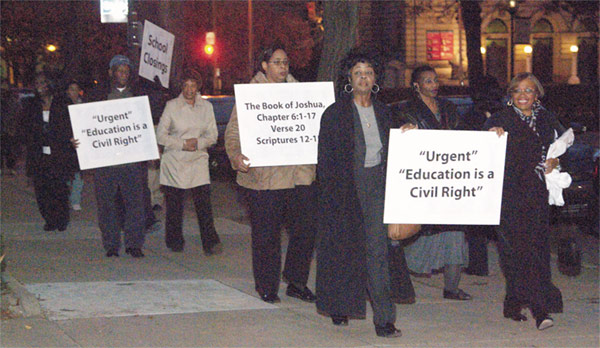In convening his Graduate Pittsburgh Summit, Mayor Luke Ravenstahl said the issue of the Pittsburgh Public Schools’ dropout rate called for a “very serious discussion” because it bears on the city’s future viability.
“We want every student to graduate and to graduate college-ready,” he told the Summit audience at the YWCA, Nov. 12.
| SCHOOL CLOSINGS— From left: NAACP First Vice President Connie Parker and President Gayle Moss lead the march in front of the Pittsburgh Public School Board building.
|
Superintendent of Schools Mark Roosevelt agreed, saying the district has to be flexible in its approach to learning, providing as many ways for students to learn as possible, three-year or five-year programs, and support for students with problems.
“When I visited the student achievement centers, the kids say they don’t want to go back to their regular classrooms (when they are back on track scholastically),” he said. “They ask, ‘Why would you put us back there when that’s where we got in trouble?’”
Certainly the most detailed presentation during the one-day summit was an analysis of dropout data by the Three Rivers Workforce Investment Board, whose President Mary Richter, noted that with the region’s aging population, addressing and reducing the dropout rate is crucial.
“This (summit) is a great next step forward,” she said.
Using a grant from the U.S. Department of Labor, the TRWIB analyzed the data from the 2006 RAND Corp. study of the Pittsburgh Public Schools dropout rate and hired the Lyceum Group to conduct 1,770 surveys, 100 peer group interviews and 123 family focus groups with dropouts.
Though social and family issues are factors in whether or not a student drops out, privacy concerns make such factors impossible to analyze or quantify. However, when asked what would have kept them interested in graduating, the top five responses are all within the control of the school district—and with the advent of the Pittsburgh Promise scholarship program, all are available to Pittsburgh Public School students. They were:
•Money for college, 79 percent;
•Access to tutors and mentors, 75 percent;
•Help for students falling behind academically, 74 percent;
•Provide students with individualized study plans for success, 74 percent, and
•Incentives/rewards for graduating, 73 percent.
But when looking at the RAND study, TRWIB Operations and Projects Director Audrey Bode said they discovered a set of “Off Track Indicators,” that are statistically significant predictors of dropouts when they appear in the sixth grade. These were attendance below 95 percent, unearned credits, over-age students and out-of-school suspensions. Dropout rates for students who exhibited one of OTIs in the sixth grade are two to four times greater than for students who exhibited none.
Nearly 80 percent of all dropouts had one OTI in the sixth grade. And for students who had multiple OTIs in the sixth grade, the dropout rate was more than five times greater. Overall, 44.1 percent of dropouts had multiple OTIs in the sixth grade.
Interestingly, Bode said, the data also showed that students who had an OTI in sixth grade, but none in seventh grade, actually had a higher graduation rate than students who never had an OTI.
“So, if we can get to them early and help them, we improve their chances for success,” she said. “The worst combination of OTIs was over-age and under-credited. The dropout rate for students with both was 46.9 percent.”
From an academic standpoint, TRWIB recommends the district expand sixth grade mentoring programs to assist students exhibiting these OTIs. It also recommends establishing a portfolio of programs to ensure students graduate ready for post-secondary education, technical training and/or employment.
(For more information on TRWIB or its analysis, call 412-552-7090 or visit www.trwib.org.)
(Send comments to cmorrow@newpittsburghcourier.com.)
